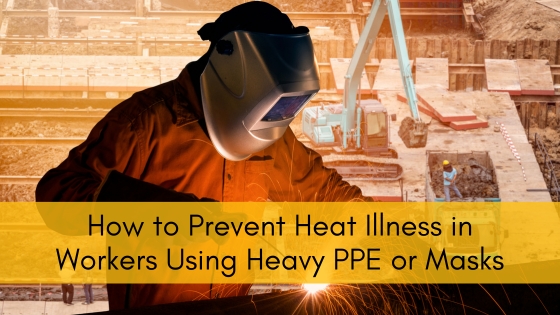Heat illness is a threat to any worker laboring in elevated temperatures, but it tends to be more intense with a faster onset in workers using heavy personal protective equipment (PPE) or masks. This has been confirmed by OSHA and CDC, which points out that personal protective equipment increases heat illness risks because:
- PPE traps environmental and exertion-related heat close to the body
- PPE often interferes with the body’s ability to remove heat by sweating
- PPE is heavier and therefore requires more exertion to move (which produces heat)
Any piece of PPE can increase heat illness risks, including certain aprons, gowns and caps, face shields, masks, respirators, gloves and boots. If your workers need this equipment to perform their jobs safely, it’s important to prioritize heat safety.
Heat Risks When Workers are Wearing Heavy PPE or Masks
Heavy PPE and masks elevate heat illness risks on their own, but there are additional environmental and work factors that can exacerbate these risks. They include:
- Isolated heat sources like commercial ovens and furnaces
- Trapped interior heat, which can emerge from many sources, including windows
- High-effort work and exertion
- Poor access to water and shade
For employers, the mission is to control these risk factors and provide workers with safer conditions.
Five Ways to Prevent Heat Illness in Workers Using Heavy PPE or Masks
Heat illness is a potential killer if it isn’t accounted for and if preventative measures aren’t put in place. Those preventative measures may include the following:
 Provide personnel with the right monitoring tools – Heat risks climb with the temperature, so it’s important for onsite personnel to track it. When certain temperature thresholds are reached, protective measures may be implemented to protect workers.
Provide personnel with the right monitoring tools – Heat risks climb with the temperature, so it’s important for onsite personnel to track it. When certain temperature thresholds are reached, protective measures may be implemented to protect workers.
A popular option is to equip workers with TWIC cards that are fitted with liquid crystal thermometer (LCT) technology. LCTs provide an accurate temperature reading quickly, and they weigh next to nothing, so they can be worn or carried with ease. TWIC cards with LCTs can also be branded with company marks or printed with important reminders (like emergency procedures).- Increase monitoring when workers are wearing PPE – If workers must wear PPE, safety personnel should increase their vigilance and be ready to check worker vitals more often. And workers must be encouraged to watch each other when the heat is on. Workers wearing PPE should never be on their own.
Part of this vigilance involves training workers to notice the signs of heat illness. Those signs include weakness, loss of coordination, confusion, slurred speech, nausea and vomiting, elevated body temperature, and in severe cases, loss of consciousness. If any of these signs are present in a heat-stressed worker, your personnel should notice it immediately and be ready to implement emergency procedures. - Implement additional work and water breaks – When workers are wearing PPE, they’ll sweat more, and they won’t cool off as easily when they do sweat. To counter this additional heat stress, your safety personnel should require additional water breaks. Adequate hydration is the surest protective measure against heat illness, but workers often neglect to drink enough water unless it’s prioritized. Reinforce this with your supervisors so it becomes part of the expected safety routine.
- Establish a cool area that’s always ready for workers – Heat illness is 100 percent preventable and easy to avoid if you prepare for it. Part of that preparation is setting up a cooling station in a shaded (preferably interior) setting. This spot should be cool and have access to cool running water, along with your other heat safety resources.
If a worker develops heat illness, this is where they should be moved to and treated until the acute heat risks have passed. - Have an heat safety emergency action plan in place for heat-related emergencies – It’s too late to plan for an emergency once the emergency occurs. Instead, your organization should have an emergency action plan (EAP) ready to go if a worker does experience heat illness.
An EAP should include a list of all onsite heat safety resources (cold wraps, electrolyte tablets, etc.) and a list of emergency steps that personnel should take. This includes where to take the afflicted person for treatment and what medical facility to contact for further treatment. Heat illness will progress rapidly if treatment is not administered right away, so workers should know exactly what to do, and when.
Heavy PPE is a Heat Risk That Can Be Mitigated with the Right Safety Measures
Heat illness can leave workers with permanent, potentially fatal complications, and the risk of experiencing heat illness climbs with PPE use. However, there are safety processes that employers can implement to protect those vulnerable workers. They include equipping workers with heat tracking tools (like LCT-modified TWIC cards), ramping up monitoring efforts, implementing additional water breaks and developing a heat-specific emergency action plan. By taking these critical steps, you can minimize worksite heat hazards and shield your employees from dangerous heat illness.






